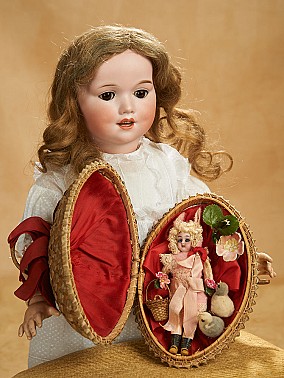Bernadine's Dollhouse
Lot #50
80"h. x 55"w. x 22"d. The gentlemen stand in the library, their top hats on the table, leather bound books crowding the bookshelves. In the well-furnished dining room, the table is set for a bountiful banquet. The parlor organ is ready for a performance, and the velvet upholstered salon furniture awaits the elegantly clad men and woman gathered for the evening entertainment. Such is the grand cabinet dollhouse known as "Bernadine's Dollhouse". Its construction was undertaken in the 1870s by Joseph Zumbusch of Hackensack, New Jersey, father of the young Bernadine. Built of fine walnut wood, the house boasted six high-ceiling rooms and a large full-length furnished garret, which were accessed by double doors at the front. At each side were four windows and a large bay window. Handmade shingles, 1200 in all, each 1" x 1 1/2", covered the high peaked roof, and the interior rooms were finished with lithographed wall papers and wooden floors. So meticulous was the construction that ten years was required for its completion. The house was, actually, a family affair. Joseph's stepfather, William Franck, a Civil War veteran, fashioned every piece of the original furnishings by hand, enhancing them with carving and marquetry, and with well-crafted drawers and doors that smoothly opened and closed. The furniture was upholstered in rich velvet and silks by Joseph's sister, Bernadine, for whom the young Bernadine had been named. Too, Aunt Bernadine created the curtains, draperies and bedspreads, as well as costuming the dollhouse people who lived there. Finally, to call the house a home, the finishing touches were needed. For these, the Zumbusch family turned to the New York toy store of FAO Schwarz from which they acquired the dollhouse people who lived there, along with chandeliers, dishes, decorative prints and porcelains, and even a Christmas tree. Upon its completion, the house was proudly labeled with a plaque that still appears on the front doors. "B. Zumbusch 1870". The house remained in the Zumbusch family for more than 90 years. In the early 1960s, Bernadine Zumbusch moved from the family estate but not before providing a hand-written history of the house, its makers and its very detailed contents. The dollhouse was acquired by Helen Brewer, a doll collector in nearby Pelham, New York, and soon thereafter, Lenore Thomas of Arizona, became its new owner. The house resided in a corner of Lenore Thomas doll room for several decades until her passing, when it was acquired by Mickie Haynes, and then Sandy Kralovetz from whose estate it is now being offered to the next fortunate collector, still all original and still as complete as when made 150 years ago. So important was the house considered that it was written about by Flora Gill Jacobs in her 1965 edition of the book, A History of Dolls' Houses, in which she described the house as a "magnificent specimen…with original dolls and furnishings in virtually mint condition". Dollhouses with a documented and continuous provenance are so rare. This is particularly so when the house retains its original and uniquely made furnishings, as well. As an example of superb craftsmanship, and with a detailed chart of every object in each room of the house when originally furnished, and with documented family history including a provenance handwritten by Bernadine Zumbusch in 1963 when she sold the house, it remains today an exceptional visual document of American childhood history.
































































































































































































































































































































































































































































































